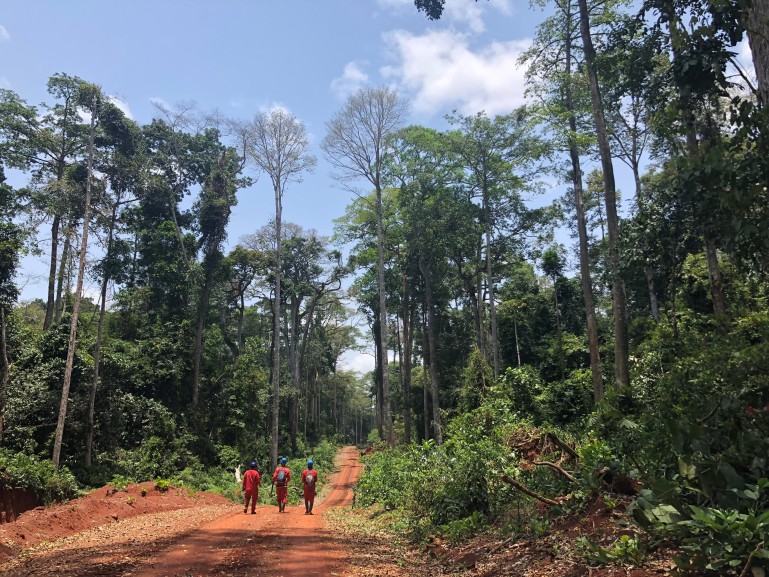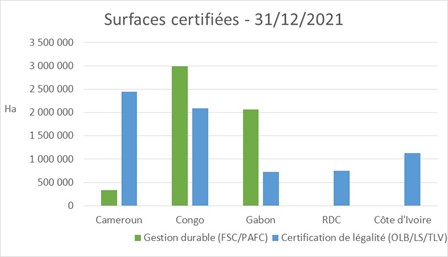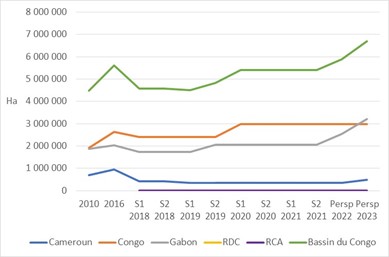

18.02.2022
Caroline Duhesme, secretary of the ATIBT Certification Commission, monitors the evolution of certification in recent years. She presents the trends and perspectives of FSC and PEFC/PAFC certification in the Congo Basin.

History
Forest certification developed late and with difficulty in Africa, particularly in Central Africa. The first FSC certificates were issued in 2005 (after an unsuccessful attempt in 1996).
In parallel, the idea of a pan-African certification was born in the early 2000s. The first operational and recognized national scheme was the PAFC Gabon in 2009 (confirmed in 2017), and a first certificate was issued in 2018.
In 2019, the initiative to develop a regional Congo Basin PAFC scheme was launched, led by ATIBT and funded by the German cooperation (KFW). The PAFC Congo Basin scheme was recognized by the PEFC at the end of 2021.
Status and prospects for FSC and PEFC/PAFC certifications
At the end of 2021, the Congo Basin had 5,392,066 ha of FSC and PAFC certified forest (representing 10% of exploitable forests), with a concession of approximately 600,000 ha being doubly certified.

Figure 1 : Status of legal and sustainable management certified areas in the Congo Basin as of 31/12/21
The evolution of the surface area has remained fairly stable, with a rather weak evolution over the last ten years. However, the outlook is rather encouraging, particularly because of the incentive policies implemented by some countries (notably Gabon, which has declared that certification will be mandatory by 2025), thanks to a certification support program, the ATIBT Fair&Precious program, and finally, with the operationalization of the Congo Basin PAFC scheme.
These initiatives were financed by the PPECF - KFW program (German cooperation).
 Figure 2 : Evolution of FSC/PEFC sustainable management certification 2010-2021 and perspective 2022-2023
Figure 2 : Evolution of FSC/PEFC sustainable management certification 2010-2021 and perspective 2022-2023
Note: These perspectives are based on PPECF surveys and information provided by companies, and assume that existing certificates remain valid.
FSC/PEFC: two approaches to certify sustainable forest management
Both FSC and PEFC promote sustainable forest management. Both schemes have a different approach: FSC is a global scheme with a set of international principles and criteria and generic requirements that can be adapted to national or regional specificities; PEFC operates according to a mechanism aiming at the recognition and validation of national schemes that meet the PEFC Council requirements.
ATIBT is equitably positioned on these 2 certification schemes, because both systems offer robust and efficient forest management standards. They may present specificities, some themes being more in-depth according to the schemes, but both allow to reach a similar level of performance in terms of forest management, and environmental and social impacts. Indeed, both systems address issues of compliance with the law, workers' rights, biodiversity, pollution, waste and greenhouse gas emissions, wildlife management, development of management plans, environmental impact, monitoring, management of high conservation value areas, etc. There is little difference in application in the field in the Congo Basin, with some companies even choosing to be doubly certified.
Both schemes are recognized and promoted by the Fair&Precious collective.
International donors also support both schemes, through projects to develop systems or standards, or to deepen issues (Payments for Environmental Services, etc).
In terms of valuation on wood markets, both systems are internationally recognized, each on specific markets. They are recognized according to the type of product, species and origin. Both are now recognized in many timber purchasing policies that encourage wood market actors to adopt responsible procurement practices. Let's mention their recognition in the French public buyer’s guide (as part of the national strategy to fight against imported deforestation), Dutch, or even in the WWF purchasing guide. They are also recognized as a risk reduction tool in the due diligence requirements of the European Union Timber Regulation (EUTR), as well as in the new draft regulation against imported deforestation in the European Union.
ATIBT channel on YouTube
ATIBT channel on YouTube